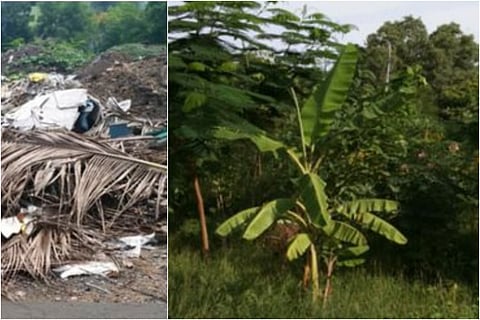

Along the banks of the Adyar River, in the heart of Chennai, sways a mini-forest of young trees, shrubs and creepers, 2,020 in number to be precise. From jamun to the mahua to the vaagai and smaller creepers, the ecosystem set up in an area of 23,000 sq ft is the result of a proven method called the ‘Miyawaki Method’.
Japanese Botanist Akira Miyawaki conceptualised and developed the Miyawaki Method, a practice of restoring lands with natural forests, brimming with species native to the land. Since the 90s this method has been widely adopted in Japan and eventually travelled to other parts of the world, restoring forest cover in degraded lands, and adding a pop of green amidst the drab of the concrete in cities. The famed Miyawaki forests are present in cities such as Bengaluru, Delhi and Hyderabad and have now reached Chennai.
The first such Miyawaki forest to come up in the heart of the city is at Kotturpuram, along the Canal Banks, on a site that was previously looked at as a “garbage vulnerable point.” Speaking to TNM, Alby John Varghese, Greater Chennai Corporation’s (GCC) Regional Deputy Commissioner (South) who spearheaded the project, says that the forest at Kotturpuram is the first of many. By the end of 2020, GCC plans on developing 10 such forests in the south Chennai region. Other such projects are underway in the north and central regions of the city as well.
“Around November last year we cleared three to four feet of construction debris from this area in Kotturpuram and prepared the soil with fresh earth from one of our lake restoration projects in the city and compost from our composting yards. We planted sapling on January 25 this year,” Alby shares. The project came to fruition with help from a private start-up called EasyForest.
Earlier this week, Alby shared pictures of how the space was transformed. “The space was particularly prone to regular dumping of construction debris. I myself made arrangements to clear it two to three times before coming up with the Miyawaki idea,” he adds.
You give a chance and the nature will amaze you.
— Dr Alby John (@albyjohnV) October 2, 2020
An 8 month old Miyawaki forest in Kotturpuram. #Change pic.twitter.com/DjGTqmienn
GCC has developed Miyawaki forests in two other areas in the city – one in an apartment complex in Valasaravakkam and another in Mugalivakkam. While an NGO called Trees Trust had helped with the second project, NGO Thuvakkam had come on board for the third. “For the first one, it was 80-20% efforts put by the Corporation and the private company. For the second and third, the NGO came forward to take care of plantation and maintenance as well. For future projects there’s more traction with private entities coming on board. We hope that it’ll be entirely done by private organisations from here on,” says Alby.
Photographs showing progress in other sites
The best thing about Miyawaki forests is that they are self-sustaining ecosystems that are cost and resource intensive only during the first two years. However, as soon as they take off, they turn out to be shelter for birds, insects and small animals, creating a thriving ecosystem of their own.
While the Corporation spent about Rs 15 lakh at Kotturpuram, the biggest Miyawaki forest yet is coming up at Puzhudhivakkam in Perungudi, which is being developed in a 10,000 sq ft area. For this project, Bengaluru-based Say Trees has come on board, with an estimated plan of spending about Rs 200 per tree.
According to Alby, the benefits of such forests in urban spaces are multi-fold. In addition to being clean and green, they also help increase the city’s lung space. “Apart from providing beautiful vistas, they also help bring down the heat island effect in areas with no green cover. These are incidental advantages,” he points out.
In the near future, when the trees grow stronger, the space can also be used by walkers and joggers. But Alby adds a word of caution, “It’s not an alternative to normal plantation. It can only be developed where there are space constraints. Under normal circumstances regular plantations are the best.”